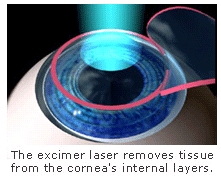Lasik
- Services
- Lasik
Facility – Lasik
Lasik is currently the most sophisticated procedure for correction of refractive errors. Lasik is an acronym for Laser Assisted Insitu Keratomileusis. In Lasik, Excimer laser is used for correction of refractiveerrors.
The Excimer laser is a “cool” laser, which does not generate heat in the cornea. The laser photons destroy intermolecular bonds in the corneal tissue resulting in tissue removal by a process called photoablative decomposition. The absence of damage to the cells surrounding the ablated tissue renders this laser particularly suitable for delicate eye procedures. Millions of people worldwide have undergone Lasik procedure for correction of refractive errors with extremely satisfactory results.
The Lasik Treatment
Pre operative evaluation
- Soft contact lens wearers must leave their lenses out for at least one week and hard lens or RGP wearers a minimum of one month for every decade of use. If you have not left your lenses out for a sufficient period of time, a dilated exam will have to be scheduled at a later date. This is because contact lens wear distorts the cornea and can produce erroneous measurements. If need be, we will ask you to return and have repeat measurements taken until stability is documented.
- It generally takes 20 to 30 minutes for the eyes to become fully dilated.
- Near vision is affected and your focusing ability will not return for roughly 2-4 hours.
- Your distance vision will not be affected (you can still wear your glasses/contacts), but we do not recommend that you drive home while your eyes are still dilated.
- Bring sunglasses. A common side effect while dilated is increased light sensitivity.
- We will not perform any type of Laser Eye Surgery without a dilated exam. We believe it is an essential part of achieving a good result.
- The surgical evaluation involves multiple examinations including:
- Biomicroscopy
- Refraction
- Tear film evaluation
- Pachymetry
- Placido topography
- Elevation topography (Orbscan/Pentacam)
- Intraocular pressure
- Wavefront analysis
The Lasik Procedure
Are you a candidate for Excimer Laser Surgery?
Procedure
- An incision is made in the cornea this corneal flap is made using an instrument called a Microkeratome which lifts a thin surface layer of the cornea away from underlying layers.
The middle layer of the cornea is thereby exposed for the laser treatment. - The surgeon focuses the laser on the exposed middle layer of the cornea. A foot pedal is depressed to activate the laser.
- The laser treatment usually lasts anywhere from a few seconds up to a minute, depending on the amount of correction needed (Fig 12).
- While the laser is running, it makes a rapid ticking sound. Each tick represents an individual pulse of the laser(Fig 13).
- After the laser reshapes the cornea, a small amount of fluid is used to wash away microscopic debris. The flap is then folded back into place (Fig 14).
- In a few minutes natural adhesive forces seal it in place without the need for sutures.
Lasik Expectations
The decision to have LASIK is an important one that ultimately, only you can make. It is important that you have realistic expectations and that your decision is based on facts, not hopes or misconceptions.
The goal of refractive surgery is to reduce your dependence on spectacles or contact lenses. It does not always create perfect. It cannot correct a condition known as prebyopia which normally occurs around age 40 and may require the use of reading glasses. In fact, people over 40 years old who have had their myopia reduced with refractive surgery may find that they need reading glasses after the procedure. Your doctor will provide you with additional information that will allow you to make an informed decision.
Make Appointment
- 10.00 AM - 08:00 PM , Monday - Friday
- 9.30 AM - 05:00 PM , Saturday
- Holiday , Sunday
- https://bit.ly/3rkHIwO
